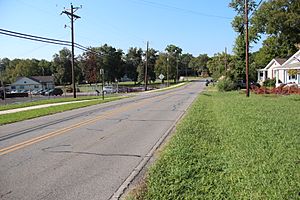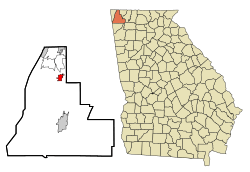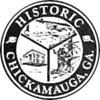Chickamauga, Georgia facts for kids
Quick facts for kids
Chickamauga, Georgia
|
|||
|---|---|---|---|

Georgia State Route 341 in Chickamauga
|
|||
|
|||

Location in Walker County and the state of Georgia
|
|||
| Country | United States | ||
| State | Georgia | ||
| County | Walker | ||
| Area | |||
| • Total | 2.86 sq mi (7.41 km2) | ||
| • Land | 2.85 sq mi (7.38 km2) | ||
| • Water | 0.01 sq mi (0.03 km2) | ||
| Elevation | 732 ft (223 m) | ||
| Population
(2020)
|
|||
| • Total | 2,917 | ||
| • Density | 1,024.23/sq mi (395.42/km2) | ||
| Time zone | UTC-5 (EST) | ||
| • Summer (DST) | UTC-4 (EDT) | ||
| ZIP code |
30707
|
||
| Area code(s) | 706/762 | ||
| FIPS code | 13-15984 | ||
| GNIS feature ID | 0355145 | ||
Chickamauga is a city in Walker County, Georgia, in the United States. In 2020, about 2,917 people lived there. It is part of the larger Chattanooga, TN–GA area.
Contents
History of Chickamauga
Before the 1800s, the Chickamauga Cherokee people lived around Chickamauga Creek. They farmed and hunted in these lands. They stayed there until they were forced to leave during the Trail of Tears in 1838.
In the early 1800s, the area that is now Chickamauga was a large plantation. In 1820, when the Cherokee Nation divided its lands, Crawfish Springs became the capital of the new Chickamauga District. After the Cherokee people were moved, the first court in Walker County was held in the old Cherokee courthouse. The local post office was called Crawfish Springs.
During the War of 1812, about 500 Cherokee warriors from this area fought with General Andrew Jackson. They fought against the Creek Indians, who were working with the United Kingdom of Great Britain and Ireland. This battle, called the Battle of Horseshoe Bend, was a victory for the U.S. Army.
The Lee and Gordon Families
The Lee and Gordon families were very important to Chickamauga's history after the Cherokee left. In 1836, James Gordon started a plantation at Crawfish Springs. He also built a grist mill (a mill for grinding grain) two miles east of town on Chickamauga Creek. This mill, called Lee and Gordon's Mill, was the first general store in the area. It was also near a blacksmith shop and a stagecoach stop. From 1840 to 1847, Gordon built his large brick house, which is now known as the Gordon-Lee Mansion. It overlooks Crawfish Springs.
Many other farm families settled in the area. Life was busy and good in the fertile valleys. But then, the American Civil War reached this quiet part of the South.
The Battle of Chickamauga
The Battle of Chickamauga was fought on September 19–20, 1863. It was named after the nearby Chickamauga Creek. More than 150,000 soldiers from the Union and Confederate armies fought in this battle.
Before the battle, Union General William Rosecrans set up his headquarters at the Gordon Lee Mansion. During the battle, wounded soldiers were cared for in the mansion and nearby buildings. Many Union doctors stayed behind to help their patients even after the Southern army won. Soldiers from both sides drank water from the town's famous springs.
Healing and Growth
In 1889, Crawfish Springs was the site of a special reunion. Soldiers from both the North and South who had fought in the Battle of Chickamauga came together. This event, called the "Blue and Gray Barbecue," helped heal old wounds. It also helped start the Chickamauga and Chattanooga National Military Park, which was created in 1890. This was the first and largest national military park in the country.
In 1888, a railroad line was built through Crawfish Springs. A group of investors bought land and built a summer resort, including the Park Hotel, which opened in 1891. The Central of Georgia Railway built a stone train station for visitors. Today, this station is home to the Walker County Regional Heritage and Model Train Museum.
The Durham Iron and Coal Company also built coke ovens in Chickamauga. These ovens turned coal into coke, which was used in iron and steel factories in Chattanooga. These coke ovens were restored in the 1990s so people could see them.
A Textile Town
In the early 1900s, Chickamauga became a town known for its textile mills. Daniel Ashley Jewell and his business partner, Colonel Bowen, bought land in Chickamauga in 1907. They built the Crystal Springs Bleachery Company in 1909. This mill was a major employer and helped the town grow. It operated until 2013. Other big companies, like Shaw Industries, also have businesses in Chickamauga.
Over the last century, Chickamauga has grown. In 1900, only 95 people lived there. By 2010, the population was 3,101. The city is surrounded by beautiful mountains and valleys. Its history has been carefully preserved and restored. Today, Chickamauga has many antique shops, unique stores, cafes, and restaurants. You can also visit public parks and historic sites like Crawfish Springs Park and Coke Oven Park.
The city's main north-south streets are named after Confederate generals. Signs explain their history and show pictures and flags from that time.
Several important Civil War battle sites and museums are near Chickamauga. These include the Chickamauga & Chattanooga National Military Park and Lookout Mountain.
Geography of Chickamauga
Chickamauga is located at 34°52′29″N 85°17′34″W / 34.87472°N 85.29278°W. The city covers about 2.86 square miles (7.41 square kilometers) of land.
Climate in Chickamauga
Chickamauga has a humid subtropical climate. This means it has cool to mild winters and hot, humid summers. There is a lot of rain, especially in the winter and spring months. On average, it rains about 57 inches (1,449 mm) each year.
Education in Chickamauga
Chickamauga has good schools for its young people.
Chickamauga City Schools
Chickamauga City Schools is a public school system. It is paid for by taxes and is open to all students who live in the city. Students who live outside the city can also attend, but they usually pay tuition. The district includes an elementary school, a middle school, and a high school, serving students from Kindergarten to 12th grade. There are about 68 full-time teachers and over 1,293 students.
Walker County Schools
For students who live outside the city limits, there are the Walker County Schools. This district has schools from pre-school to 12th grade. It includes nine elementary schools, four middle schools, and two high schools. There are about 577 full-time teachers and over 8,844 students in this district.
Other Schools
- Walker County Alternative Education Center: This center is for students who need a different learning environment. It is located in the building that used to be Osburn Elementary School.
- Oakwood Christian Academy: This is a private Christian school founded in 1992. It offers classes from Pre-K through 12th grade, with over 275 students. The school also has sports teams like cheerleading and basketball.
Culture and Tourism in Chickamauga
Chickamauga has many interesting places to visit.
Tourist Attractions
- Lee and Gordon's Mills: This is one of the oldest mills in Georgia. It is located about two miles east of the town center on Chickamauga Creek.
- Walker County Regional Heritage and Model Train Museum: This museum is in the old stone train station. It has Civil War items, Native American artifacts, old guns, furniture, and a working display of model trains from 1947.
- Chickamauga Coke Ovens: These old ovens are just north of downtown Chickamauga. They were used to turn coal into coke for iron and steel factories.
- Gordon Lee Mansion: This beautiful mansion was built by James Gordon between 1840 and 1847. Today, it is a bed and breakfast, restaurant, and event center.
- Crawfish Spring: This spring was the main water source for early settlers and the city. It is now a park with picnic tables, a swing, and a gazebo.
- Holland-Watson Veterans' Park: This park was dedicated in 2002 to honor two Chickamauga soldiers, Sgt. Eddie H. Holland and Cpl. Thomas A. "Tommy" Watson, who died in the Vietnam War. A Huey helicopter is on display in the park.
From April to September, the Tennessee Valley Railroad Museum offers train trips from Chattanooga to Chickamauga on weekends.
Notable People from Chickamauga
- Ashley Harkleroad, a former professional tennis player
- Steve Tarvin, a member of the Georgia House of Representatives
Population of Chickamauga
| Historical population | |||
|---|---|---|---|
| Census | Pop. | %± | |
| 1900 | 95 | — | |
| 1910 | 312 | 228.4% | |
| 1920 | 965 | 209.3% | |
| 1930 | 1,715 | 77.7% | |
| 1940 | 1,665 | −2.9% | |
| 1950 | 1,747 | 4.9% | |
| 1960 | 1,824 | 4.4% | |
| 1970 | 1,842 | 1.0% | |
| 1980 | 2,232 | 21.2% | |
| 1990 | 2,149 | −3.7% | |
| 2000 | 2,245 | 4.5% | |
| 2010 | 3,101 | 38.1% | |
| 2020 | 2,917 | −5.9% | |
| U.S. Decennial Census 1850-1870 1870-1880 1890-1910 1920-1930 1940 1950 1960 1970 1980 1990 2000 |
|||
In 2020, there were 2,917 people living in Chickamauga. The population was mostly White (92.53%), with smaller percentages of Black or African American, Native American, Asian, and people of two or more races. About 1.44% of the population was Hispanic or Latino.
See also
 In Spanish: Chickamauga (Georgia) para niños
In Spanish: Chickamauga (Georgia) para niños



